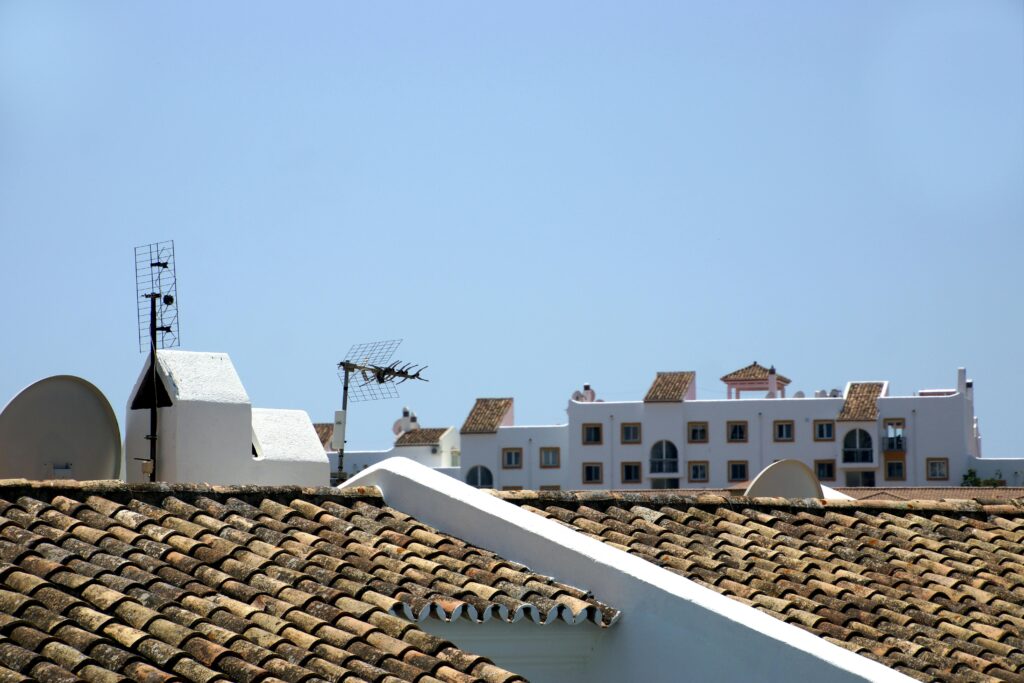You might be wondering which option offers the best protection, longevity, and aesthetic appeal for your home. Maybe you’ve heard stories praising the sleek resilience of metal roofs or considered the timeless charm of traditional clay tiles. In this article, we will unpack the vital advantages and disadvantages of these two popular roofing materials, helping you make an informed choice.
By the end of this guide, you’ll understand key factors such as installation costs, maintenance requirements, environmental impact, and visual appeal. Whether you’re building a new home or planning a roof replacement, exploring the Metal Roofing vs. Traditional Tile Pros and Cons will empower you to select the roofing that truly fits your needs and budget. Let’s get started and uncover which roofing style comes out on top for your next project!
Key Takeaways
- Balance Cost & Longevity: Metal roofs offer long-lasting durability at moderate cost, while traditional tiles have higher upfront prices but can last up to a century.
- Assess Weight & Structure: Metal panels are lightweight and easy on framing, whereas tiles are heavy and may require reinforced support.
- Evaluate Energy Performance: Metal reflects solar heat to reduce cooling bills; tiles absorb and release heat to stabilize indoor temperatures.
- Installation Speed vs. Craftsmanship: Metal systems install quickly with fewer labor hours; tile roofs demand meticulous placement and longer timelines.
- Maintenance Needs: Metal requires minimal upkeep and resists mold, while tiles may crack or displace and need periodic inspections.
- Match Aesthetics & Climate: Metal suits modern designs and storm-prone areas; tile complements Mediterranean or classic homes and excels in dry, temperate climates.
- Consider Environmental Impact: Metal is often recyclable and sometimes made from recycled content; tile production involves more energy but offers exceptional longevity.
Table of Contents
ToggleWhy Understanding the Battle Between Metal Roofing and Traditional Tile Matters
When it comes to choosing the perfect roofing material for your home or commercial building, the debate between metal roofing and traditional tile is more relevant than ever. Both options have carved their places in construction history, but understanding their unique benefits and drawbacks can save you money, time, and a lot of headaches down the line. Metal roofing and traditional tile aren’t just roofing choices, they embody different styles, functionalities, and lifespans that cater to diverse needs.
Metal roofing refers to roofing panels or shingles made of materials such as steel, aluminum, or copper, designed to offer durability and modern aesthetics. Traditional tile, typically made from clay or concrete, has adorned roofs for centuries, blending natural beauty with strong protection. According to the Metal Roofing Alliance, metal roofs can last 40 to 70 years, whereas traditional tile roofs usually have a lifespan of 50 to 100 years, depending on the type. But lifespan is just one part of the story.
Why is this comparison critically important? For starters, roofing impacts everything from energy efficiency to structural integrity to resale value. The U.S. Department of Energy notes that metal roofs can reflect up to 70% of solar radiant heat, helping reduce cooling costs during hot months. Conversely, traditional tile’s natural thermal mass provides excellent insulation, keeping homes cooler in the summer and warmer in the winter, an advantage especially valuable in Mediterranean or temperate climates.
Consider the story of a homeowner in California who switched from traditional clay tiles to a metal roofing system. Despite initial concerns about metal roofs being noisy during rainstorms, this upgrade resulted in a 25% reduction in their annual energy bills and a higher appraisal value when selling the house. This example underlines how the right roofing choice, aligned with environmental factors and personal priorities, greatly influences both comfort and financial outcomes.
In essence, knowing the pros and cons of metal roofing vs traditional tile empowers you to make an informed decision tailored perfectly to your geographical location, budget, and aesthetic preference. This knowledge is essential, not just to protect your investment, but also to enhance the living or working environment under your roof. As we dive deeper into the specific advantages and disadvantages of each, keep in mind that the best roofing choice is the one that fits your unique needs and long-term goals.
How to Choose Between Metal Roofing and Traditional Tiles: A Step-by-Step Guide
Deciding between a metal roof and traditional tile roofing can feel overwhelming given the many factors to consider. To help you make an informed choice, here’s a detailed, easy-to-follow process that highlights the essential steps. By following this guide, you’ll be equipped to select the roofing option that best fits your needs, budget, and aesthetics.
1. Assess Your Budget
Start by determining how much you’re willing to spend on your roofing project. Metal roofing and traditional tiles vary significantly in cost.
– Metal Roofs: Typically range from $5 to $12 per square foot, depending on the type of metal (steel, aluminum, copper).
– Traditional Tiles: Clay or concrete tiles usually range from $7 to $15 per square foot, considering installation and material quality.
Keep in mind that while metal roofs can have a higher upfront cost, they often save money in the long run due to durability and energy efficiency.
2. Evaluate Your Climate and Environment
Your local weather conditions heavily influence which roofing material performs better.
– Metal Roofs: Ideal for snowy or rainy climates because they shed water and snow quickly. They also reflect solar heat, helping in hot climates.
– Traditional Tiles: Well-suited for warm, dry climates. Clay tiles have excellent thermal properties but can be fragile in regions with freeze-thaw cycles.
Research the weather patterns in your area and consider which material will withstand them better over time.
3. Consider Aesthetic Preferences and Architectural Style
Your roof doesn’t just protect your home, it’s a key element of curb appeal.
– Metal Roofing: Offers modern, sleek designs and a variety of finishes. It can mimic the appearance of traditional materials like shingles or wood shakes.
– Traditional Tiles: Bring timeless beauty and elegance, especially for Mediterranean, Spanish, or Southwestern-style homes.
Look for examples online or in your neighborhood to envision how each roofing type complements your home’s architecture.
4. Analyze Durability and Maintenance Needs
Longevity and upkeep are critical for any roofing decision.
– Metal Roofs: Known for exceptional durability, often lasting 40-70 years. They resist cracking, shrinking, and erosion but may be prone to denting.
– Traditional Tiles: Can last 50-100 years with proper maintenance but are susceptible to cracking under heavy impact. Maintenance includes regular inspections and occasional tile replacements.
Consider your willingness to perform or pay for maintenance over the roof’s lifespan.
5. Examine Energy Efficiency and Environmental Impact
Sustainability is increasingly essential in roofing choices.
– Metal Roofs: Reflect radiant heat, helping reduce cooling costs in warmer climates, and often contain recycled materials. They’re also 100% recyclable at the end of their life.
– Traditional Tiles: Offer excellent insulation, helping regulate indoor temperatures. Some tiles are eco-friendly, but their production often involves more energy consumption.
Evaluate how each roofing option aligns with your environmental values and energy goals.
6. Understand Installation Complexity and Timeframe
Installation affects both cost and disruption to your daily life.
– Metal Roofs: Generally faster to install due to light weight and large panels, often taking only a few days.
– Traditional Tiles: Heavier and more fragile, requiring slower, more meticulous installation that can last a week or longer.
Ask contractors about their experience installing each roofing type and request timelines before deciding.
7. Factor in Local Building Codes and HOA Rules
Before finalizing your choice, check for regulations that may limit your options.
– Some neighborhoods or municipalities have strict guidelines on roofing materials and colors.
– Ensure the roofing you choose complies with zoning laws and homeowner association requirements.
Choosing between a metal roof and traditional tiles requires balancing cost, durability, aesthetics, and environmental considerations. Use this step-by-step guide as a framework to evaluate what matters most to you. Consulting with reputable roofing contractors will also provide personalized insights based on your home’s specifics.
By following these steps, you’ll feel confident in selecting the right roofing material that stands the test of time while enhancing your property’s value and curb appeal.

Tips for Choosing Between Metal Roofing and Traditional Tile Roofing: Pros and Cons
✅ Metal Roofing: Lightweight & Durable
Metal roofs are significantly lighter than traditional tiles, reducing structural stress. They also offer excellent durability, resisting severe weather conditions like heavy rain and snow.
❌ Metal Roofing: Initial Cost Can Be Higher
Although metal roofs save money over time, the upfront cost often exceeds that of traditional tiles, which might be a consideration for budget-conscious homeowners.
✅ Traditional Tile: Aesthetic Appeal & Variety
Tiles come in various shapes, colors, and textures, providing a timeless look that can enhance your home’s curb appeal, particularly for Mediterranean or Spanish-style architecture.
❌ Traditional Tile: Fragility and Weight
Tiles are heavier and can crack or break easily under impact, requiring a stronger supporting structure and periodic maintenance or replacement.
✅ Metal Roofing: Energy Efficiency
Metal roofs reflect solar radiant heat, helping to keep homes cooler during hot seasons and potentially reducing air conditioning costs.
❌ Traditional Tile: Heat Retention
Tile roofs absorb heat, which can lead to higher indoor temperatures and more energy usage for cooling in warm climates.
✅ Metal Roofing: Quick & Easy Installation
Due to their larger panels and lighter weight, metal roofs can be installed more quickly compared to individually placing tiles, saving on labor costs and time.
❌ Traditional Tile: Longer Installation Time
Tile roofs typically require more time and specialized skills to install, which might delay construction or renovation schedules.
✅ Metal Roofing: Low Maintenance
Once installed, metal roofs require minimal maintenance, resisting moss, algae, and insect damage that can affect tile roofs over time.
❌ Traditional Tile: Higher Maintenance Needs
Tiles can get mossy, cracked, or displaced, especially in humid or rainy environments, necessitating periodic cleaning and repairs.
💡 Extra Tip: Consider Local Climate and Building Codes
Factor in your regional weather patterns and regulations, since some areas favor metal roofing for durability or traditional tiles for heritage preservation.
Key Concepts
When diving into the debate of Metal Roofing vs. Traditional Tile: Pros and Cons, it is essential to first unravel the foundational ideas that frame this comparison. Each roofing material carries with it a spectrum of characteristics that resonate differently depending on environmental, aesthetic, and functional perspectives. Understanding these core concepts offers a gateway to grasp why one might be favored over the other in various contexts.
Material Composition: The Heart of the Debate
At the core, the term Metal Roofing refers to roofing systems primarily composed of metals like steel, aluminum, or copper. These materials are transformed into sheets or panels that interlock or overlap to create a resilient barrier atop buildings. Their strength and flexibility often evoke images of armor, not just protecting but also adapting to the structure beneath.
On the other side, traditional tile roofs are often crafted from clay or concrete, shaped and fired or cured to form rigid, heavy tiles reminiscent of classical Mediterranean architecture. Each tile lies like a brick in a fortress, its solidity offering a sense of permanence and timelessness. This heaviness contrasts starkly with the lighter, more agile nature of metal roofing, highlighting their fundamental physical divergence.
Durability and Longevity: Stories in Time
Durability isn’t just a trait; it’s the narrative of a roof’s life. Metal roofs embody a kind of enduring saga, withstanding storms and temperature swings much like a seasoned traveler who adapts yet remains unbroken. Their resistance to corrosion, punctures, and weathering often outstrips traditional tiles, which tell a different story , one of endurance grounded in mass and density. Tile roofs can last centuries, their weathered surfaces narrating tales of bygone eras, but they are also vulnerable to cracking under impact or shifting foundations.
This interplay of resilience versus fragility depicts not a simple battle but a dance between materials shaped by time and environment.
Thermal Performance: The Dance of Heat and Design
One cannot ignore the poetic exchange between roofing materials and the sun’s relentless gaze. Metal roofs often reflect solar radiation, much like a mirror sending back a blazing sunbeam, reducing heat absorption and subsequently cooling homes beneath. This reflective quality can impart energy efficiency, diminishing the demand on air conditioning systems.
Traditional tiles, with their mass and clay composition, act more like thermal blankets , absorbing heat during the day and releasing it slowly at night. This slow release can be a quiet guardian against drastic temperature swings, offering a steady warmth in cool climates and a soothing inertia to daytime heat accumulation.
Aesthetic Appeal: The Poetry of Appearance
The visual impact of roofing materials transcends utility, entering the realm of personal and cultural expression. Metal roofs offer a more modern, sleek aesthetic , smooth, clean lines that can mimic other materials through creative finishes. Their versatility is akin to a chameleon’s ability to shift forms, allowing architects and homeowners to experiment with colors and shapes.
Traditional tiles carry centuries of heritage, their curved profiles and earthy tones evoking nostalgia and craftsmanship. They paint rooftops with strokes of history, often enhancing the architectural narrative of neighborhoods and entire regions. This aesthetic permanence is as much about identity as it is about design.
Installation and Structural Considerations: The Framework Beneath
The process and structural demands of installing each roofing type can be imagined as the choice between laying a solid stone path and weaving a flexible fabric. Metal roofs, lightweight and pliable, can be affixed over existing roofing, causing less disruption and stress to building frameworks. Their installation often resembles the fitting of armor plates, carefully aligned and sealed.
Traditional tiles, heavy and brittle, require robust support structures. The underlying framework must bear their significant weight, forcing builders to consider architectural reinforcements. The installation assumes a ritualistic precision , each tile placed to interlock perfectly, much like pieces of a mosaic.
Environmental Impact: The Green Lens
Looking through an ecological lens reveals distinct narratives. Metal roofing often enjoys the reputation of being recyclable and sometimes crafted from recycled materials, positioning it as a champion of sustainability. It represents a cycle of rebirth, where materials are not discarded but continually repurposed.
Clay and concrete tiles tell a different environmental story. Made from natural earth materials, they embody the raw connection to the planet but demand energy-intensive processes for shaping and firing. Their longevity means fewer replacements, which offsets some initial environmental costs, creating a balance in the sustainability equation.
By examining these key concepts , material composition, durability, thermal performance, aesthetics, installation, and environmental impact , the essential contrasts and synergies between metal roofing and traditional tile emerge. These foundational ideas illuminate why the choice between these two roofing types is far more than a simple selection; it becomes a dialogue between history and innovation, strength and beauty, practicality and expression.
Frequently Asked Questions (FAQs) about Techumbre Metálica vs. Traditional Tile Roofing: Pros and Cons
❓ What are the main advantages of techumbre metálica compared to traditional tile roofing?
Techumbre metálica (metal roofing) is known for its durability, lightweight nature, and quick installation. It is resistant to extreme weather, requires less maintenance, and has a longer lifespan compared to traditional tile roofing. Additionally, metal roofing is energy-efficient, reflecting heat and reducing cooling costs.
❓ Are there any disadvantages to choosing techumbre metálica over traditional tile roofs?
Yes, some drawbacks include higher upfront costs and potential noise during rain or hail. Metal roofs can also be prone to denting if struck by large debris. Aesthetically, they may not match the classic look that many prefer with traditional tile roofing.
❓ How does the cost of techumbre metálica compare with traditional tile roofing?
Typically, techumbre metálica has a higher initial installation cost but tends to save money over time due to its durability and low maintenance needs. Traditional tile roofs can be cheaper upfront but might entail more frequent repairs and replacements.
❓ Which roofing option is better for insulation and energy efficiency?
Techumbre metálica generally offers better energy efficiency because it reflects sunlight and reduces heat absorption. Traditional tiles provide good thermal mass, which can help moderate indoor temperatures but may not perform as well in extreme heat without additional insulation.
❓ Is one roofing material more environmentally friendly than the other?
Techumbre metálica is often considered more environmentally friendly because it is usually made from recyclable materials and can be recycled at the end of its life. Traditional tiles are made from natural materials, but their heavier weight increases transportation emissions. Both options can be eco-friendly with the right manufacturing and disposal practices.



2 Responses